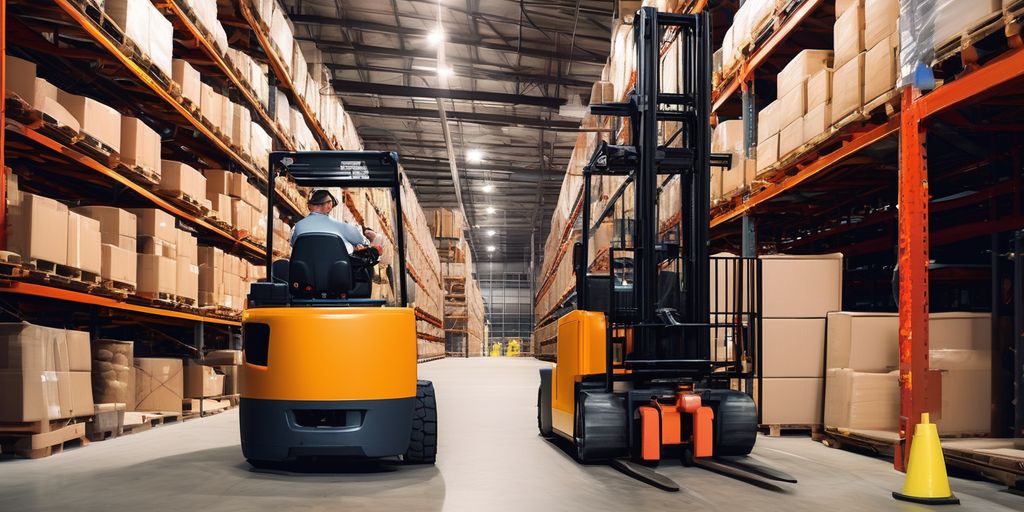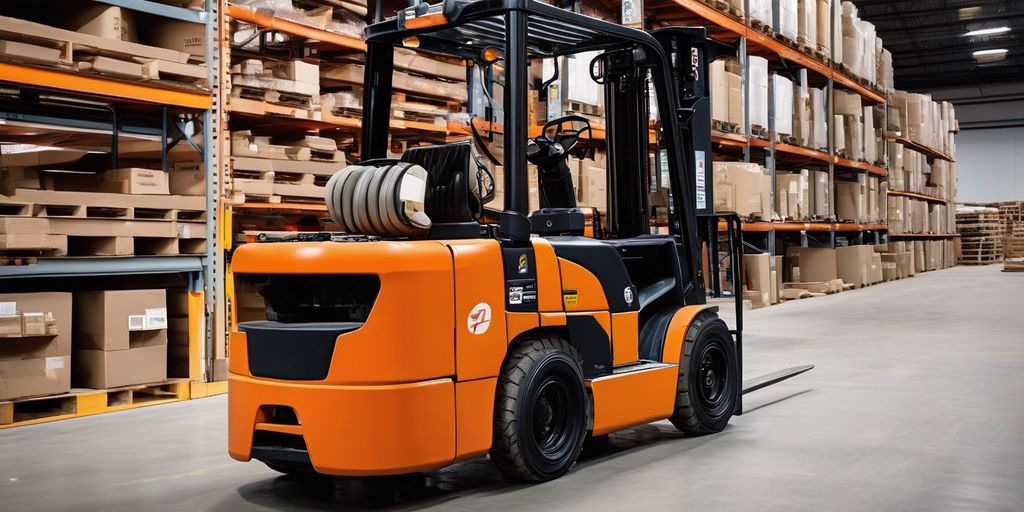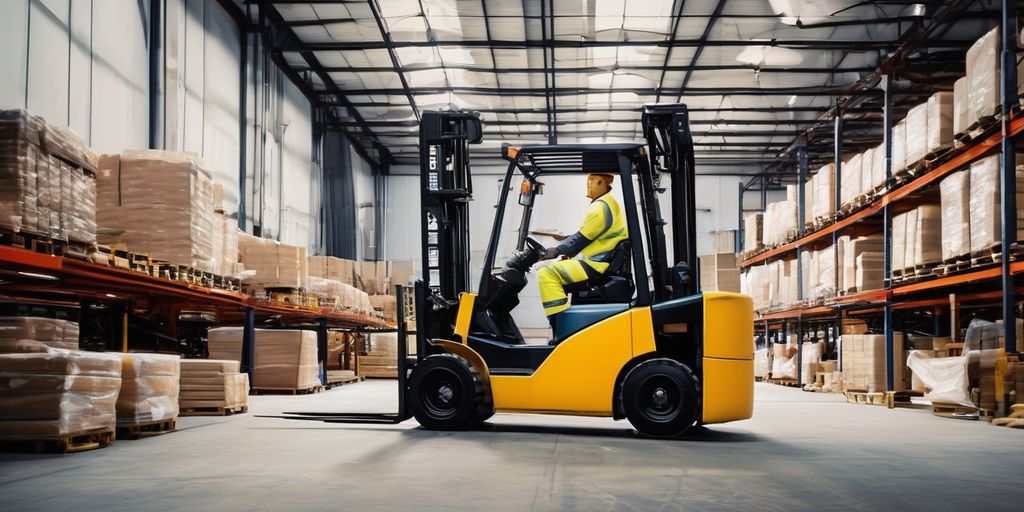Forklift Safety Training enhances workplace safety by providing operators with comprehensive knowledge and skills to safely operate forklifts, reducing the risk of accidents, injuries, and property damage. The safety training course also ensures compliance with regulatory standards, as OSHA mandates formal training for forklift operators. Meeting these standards not only avoids legal penalties but also fosters a culture of safety within the workplace.
Key Takeaways
- Forklift Safety Training significantly reduces the risk of workplace accidents and injuries.
- Compliance with OSHA regulations is mandatory for forklift operators and helps avoid legal penalties.
- Effective training programs include a comprehensive curriculum, hands-on practice, and assessment for certification.
- Implementing safety measures such as creating safe work zones and regular equipment inspections enhances workplace safety.
- Advanced training techniques like virtual reality simulations and continuous education programs improve operator skills and safety awareness.
Understanding the Importance of Forklift Safety Training
Forklift Safety Training enhances workplace safety by providing operators with comprehensive knowledge and skills to safely operate forklifts, reducing the risk of accidents, injuries, and property damage. The safety training course also ensures compliance with regulatory standards, as OSHA mandates formal training for forklift operators. Meeting these standards not only avoids legal penalties but also fosters a culture of safety within the workplace.
Key Components of Effective Forklift Safety Training
Comprehensive Curriculum
A comprehensive curriculum is essential for effective forklift safety training. It should cover all aspects of forklift operation, including safety protocols, maintenance procedures, and emergency response. This ensures that operators are well-versed in both the theoretical and practical aspects of forklift use.
Hands-On Practice
Hands-on practice is crucial for operators to gain experience in a controlled environment. Practical sessions allow operators to apply what they've learned in real-world scenarios, helping to solidify their skills and knowledge. This approach not only enhances operator competence but also boosts confidence in handling forklifts safely.
Assessment and Certification
Assessment and certification are vital components of any forklift training program. Operators must be evaluated to ensure they have mastered the necessary skills and knowledge. Certification serves as proof of their competence and is often required to meet regulatory standards. Employers are required to keep detailed records of all forklift training conducted, including certification dates and the subjects that were taught.
A forklift training checklist is a structured document or tool that outlines the key components needed to conduct effective forklift safety training.
OSHA Regulations and Compliance
Mandatory Training Requirements
OSHA’s mission is clear: to prevent work-related injuries, illnesses, and deaths by issuing rules on everything from forklift operation to emergency exits. Employers are responsible for providing a safe working environment that complies with OSHA regulations. This includes conducting regular inspections, providing essential safety training to employees, and correcting any identified hazards promptly.
Avoiding Legal Penalties
Failure to comply with OSHA regulations can result in significant fines and penalties. Ensuring compliance with OSHA standards is crucial to protect employees and customers from potential hazards.
Maintaining Compliance
The Occupational Safety and Health Administration, known as OSHA, plays a crucial role in ensuring workplace safety across the United States. Created by Congress under the Occupational Safety and Health Act of 1970, this agency sets and enforces protective workplace safety and health standards.
Understanding OSHA regulations for forklift operations is essential for maintaining a safe and compliant workplace.
Implementing Safety Measures in the Workplace
Creating Safe Work Zones
Creating designated lanes to separate forklift traffic from pedestrians is crucial. Barriers and warning signs should be strategically placed to enhance safety. Awareness of hazardous situations in the workplace is essential for preventing accidents.
Regular Equipment Inspections
Conducting daily equipment inspections is a must. This ensures that any potential issues are identified and addressed promptly, reducing the risk of accidents. Regular inspections also help in managing forklift maintenance costs effectively.
Emergency Preparedness
Planning and preparation to avoid hazardous situations are vital. Employees should be trained on emergency procedures and the use of safety equipment. A transparent communication system should be in place to ensure everyone is aware of the safety protocols.
Enforce safety policies at every opportunity to protect your staff from forklift incidents. Ensure employees know the consequences of violating safety guidelines and rules.
Benefits of Forklift Safety Training for Employers
Reducing Operational Costs
Investing in forklift safety training can significantly reduce operational costs. By minimizing accidents and equipment damage, companies can save on repair and replacement expenses. Additionally, properly trained operators are more efficient, leading to lower fuel consumption and maintenance costs.
Improving Employee Morale
A safe working environment boosts employee morale. When workers feel safe, they are more likely to be satisfied with their jobs and remain loyal to the company. This can lead to lower turnover rates and higher productivity.
Enhancing Productivity
Proper forklift training doesn't just lead to safer workplaces but also increases productivity. When trained to operate forklifts efficiently, they can move materials faster and more accurately, maximizing efficiency in forklift fleet management through operator training, scheduled maintenance, facility layout optimization, and cost-saving strategies.
A well-trained workforce is a productive workforce. Investing in safety training is an investment in your company's future.
Advanced Training Techniques
Virtual Reality Simulations
Virtual reality (VR) simulations offer a cutting-edge approach to forklift safety training. These simulations provide a realistic and immersive environment where operators can practice handling various scenarios without the risk of real-world consequences. By combining thorough training, adherence to OSHA guidelines, and integrating advanced safety solutions, forklift safety can be significantly enhanced.
Interactive Learning Modules
Interactive learning modules are designed to engage operators through multimedia content, quizzes, and real-time feedback. These modules can be accessed online, allowing for flexible learning schedules. They are particularly effective in reinforcing theoretical knowledge and ensuring that operators understand the importance of forklift training in accident prevention.
Continuous Education Programs
Continuous education programs ensure that forklift operators stay updated with the latest safety practices and regulations. These programs often include periodic refresher courses and advanced training techniques to keep skills sharp and knowledge current. Employers can benefit from these programs by maintaining a high level of safety and compliance in their operations.
Investing in advanced training techniques not only enhances operator skills but also fosters a culture of safety within the workplace.
Roles and Responsibilities in Forklift Safety

Employers play a crucial role in ensuring forklift safety. They must provide comprehensive training programs and ensure that all operators are certified and competent. Additionally, employers should maintain detailed records of all training sessions, including certification dates and subjects covered. Regular safety training should be conducted for all employees who work near forklifts to ensure everyone is aware of safety protocols.
Forklift operators are responsible for safely operating forklifts to move materials, load and unload trucks, stack pallets, and perform other tasks in warehouses. They must conduct routine inspections and fix any minor issues on the forklifts, checking for signs of wear and tear. Operators should also understand basic maintenance tasks to keep the forklift in optimal working condition and follow safety protocols for fueling, refueling, and handling batteries.
Safety managers oversee the implementation of safety measures and ensure compliance with industry standards. They are responsible for creating safe work zones, conducting regular equipment inspections, and preparing for emergencies. Safety managers must also ensure that all safety protocols are followed and that any incidents are thoroughly investigated to prevent future occurrences.
Conclusion
Forklift Safety Training is an essential component in ensuring the safety and efficiency of your operations. By equipping operators with the necessary knowledge and skills, you significantly reduce the risk of accidents, injuries, and property damage. Compliance with OSHA's regulatory standards not only helps avoid legal penalties but also promotes a culture of safety within the workplace. Investing in comprehensive training programs for all individuals involved in forklift operations—from operators to supervisors—fosters a safer and more productive work environment. Prioritizing safety measures and continuous education is key to protecting your workforce and maintaining smooth operations.
Frequently Asked Questions
What is the primary purpose of forklift safety training?
Forklift Safety Training enhances workplace safety by providing operators with comprehensive knowledge and skills to safely operate forklifts, reducing the risk of accidents, injuries, and property damage. It also ensures compliance with regulatory standards, such as those mandated by OSHA.
Who should enroll in forklift safety training?
This training is ideal for individuals operating forklifts in various settings, including industrial workplaces, warehouses, and construction sites. It includes new operators, experienced operators, employers, supervisors, safety managers, warehouse workers, and anyone involved in material handling tasks.
What are the key components of effective forklift safety training?
Effective forklift safety training includes a comprehensive curriculum, hands-on practice, and assessment and certification. These components ensure that operators are well-prepared to handle forklifts safely and efficiently.
How does forklift safety training help in complying with OSHA regulations?
OSHA mandates formal training for forklift operators. Completing a forklift safety training course helps businesses meet these regulatory standards, avoiding legal penalties and fostering a culture of safety within the workplace.
What safety measures can be implemented to prevent forklift incidents?
To prevent forklift incidents, implement safety measures such as barriers, designated lanes to separate forklift traffic from pedestrians, warning signs, awareness of hazardous situations, and thorough planning and preparation to avoid hazards.
What are the benefits of forklift safety training for employers?
Forklift safety training helps reduce operational costs, improve employee morale, and enhance productivity. By ensuring a safer work environment, employers can also avoid legal penalties and foster a culture of safety.




Leave a comment
This site is protected by hCaptcha and the hCaptcha Privacy Policy and Terms of Service apply.